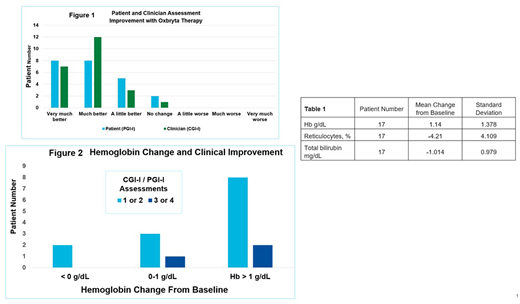Background:
Sickle cell disease (SCD) is an inherited disorder in which sickle hemoglobin (HbS) polymerization triggers red blood cell sickling, chronic hemolysis, anemia and episodic vaso-occlusion. Complications include cumulative organ damage and disability as well as accelerated mortality. OxbrytaTM is a first-in-class therapy that increases hemoglobin (Hb) levels and reduces markers of hemolysis and is FDA-approved for treatment of SCD in patients 12 years of age or older. We report here the single-center experience of patient-perceived benefit in 27 consecutive patients treated with OxbrytaTM tablets for at least 8 weeks.
Methods:
We collected clinical data on 27 consecutive patients with SCD at The University of Texas Comprehensive Sickle Cell Center under an approved data collection protocol for standard-of-care clinical data. All patients with at least 8 weeks of data collection are included. The Standing Data Collection Protocol was amended to allow collection of Patient Global Impression - Improvement scale (PGI-I) data. Four patients did not have complete laboratory and PGI-I data. Data analysis was done on 23 patients for whom there is information on Hb, retic %, CGI-I, and PGI-I. Seventeen of the patients had complete laboratory data while 23 patients provided PGI-I information. Laboratory test frequency was limited by COVID-19 pandemic restrictions.
Results:
Twenty-three patients whose data were analyzed ranged in age from 20 to 66 years, with 65 % being female. HbS genotypes were 91 % SS and 9 % Sβ°-thalassemia. No patient had Sβ+-thalassemia or hemoglobin SC. Table 1 shows the impact of OxbrytaTM on key laboratory parameters. The Hb improved with treatment to a degree comparable to that seen in the HOPE Trial. The healthcare provider assessed each patient for improvement with OxbrytaTM treatment using the 7-point Clinical Global Impression - Improvement scale (CGI-I). In addition, each patient provided an assessment of improvement with OxbrytaTM treatment using the 7-point PGI-I scale. Figure 1 shows the results of these assessments. Most patients report substantial improvement which correlates with the clinician impression. We noticed that for some of the patients who reported significant clinical improvement (very much better or much better symptoms) hemoglobin values declined or improved only slightly from baseline (Figure 2). Hence, Hb increase of > 1 g/dL is not needed for clinical improvement. About 30% of the patients reported mild to moderate diarrhea, that was managed with reduction in OxbrytaTM dose until diarrhea improved followed by titration back to recommended dose. For more severe diarrhea, OxbrytaTM was interrupted for 2 to 3 days followed by restart at a lower dose.
Conclusions:
This study is the first to utilize the 7-point PGI-I scale and CGI-I to assess SCD improvement with OxbrytaTM treatment. Figure 1 shows patient and clinician assessment of change in symptoms or clinical status with OxbrytaTM therapy. Most patients report substantial improvement, which correlates with the clinician impression. The majority of patients (16/23; 70%) reported much improved or very much improved symptoms while 22% reported minimally improved and only 8% reported no change in symptoms. The clinician impression correlated well with patients' impression of their improvement. Most of the responses, (19/23; 83%), were much improved and very much improved; whereas, 13% were minimally improved and 4% no change. Some patients also mentioned that their energy level improved significantly and that they had less pain at their typical sites of chronic pain while on OxbrytaTM therapy.
In this study, patient hemoglobin values improved with treatment to a degree comparable to that seen in the HOPE Trial. Figure 2 shows that clinical improvement can occur for patients whose hemoglobin declined or improved only slightly from baseline. Our data collection is limited due to COVID-19 pandemic restrictions; most of the patients were unable to have laboratory assessments as frequently as desired. In summary, our study suggests that most sickle cell disease patients perceive benefit with OxbrytaTM therapy in terms of improvement in their condition and level of functioning.
Idowu:Cyclerion Therapeutics, Inc: Research Funding; Pfizer: Research Funding; Novartis: Membership on an entity's Board of Directors or advisory committees, Research Funding; Global Blood Therapeutics: Membership on an entity's Board of Directors or advisory committees, Research Funding, Speakers Bureau.
Author notes
Asterisk with author names denotes non-ASH members.


This feature is available to Subscribers Only
Sign In or Create an Account Close Modal